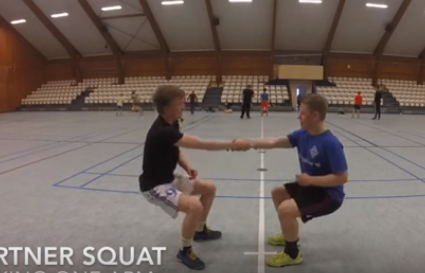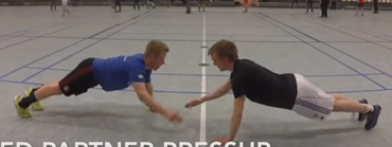Korfball drills
- give each other the right arm and bend your knees in a sitting position.
- idem left arm

Two persons face to face in a lying position. They push themselves up and give each other a hand slap (see photo)

In short: practice various forms of the shot in a fun competition format.
Organisation:
- Each group has a basket and a ball, the baskets should preferably (but not necessarily) be arranged in a circle or rectangle.
- The number of people per group is less important (all groups should be about the same size).
The first assignment for the groups is:
- score 10 goals with a walkthrough.
- When you are done, the creator of the last goal goes to the trainer to get the next assignment.
- Which group will have completed all assignments first?
The trainer walks around in the mean time,
- giving encouragement or correcting here and there.
- He has a piece of paper with a list of assignments.
- When someone comes to get the next assignment, first ask him which assignment he just did (it can vary a lot after a while) and then give the next one.
- A sample list:
- 10 passing balls,
- 15 penalty shots,
- 10 shots from 5 meters,
- 10 through balls from behind the basket,
- 5 dodge balls next to the post,
- 5 shots from 4 meters behind the basket,
- 5 small chances with 1 hand.
- Everything is possible of course, a lot of momentum comes when the number of goals to be scored is kept small.
- Pawn at 6/7 meters in front of the basket.
- Attackers under the basket. In a circuit take through balls.
- Do you score? Then change with the person under the basket where you scored.
- Two pairs at a basket.
- Number one shoots, number two duels for the catch.
- If you have the ball first, play the ball to your teammate who can then shoot.
- Change every goal, the first to score five goals wins the game.
- points of interest:
- Good blocking of opponent without foul
- 3 lines a few meters apart.
- Each line has a name (apple pear or banana).
- The children start on a line.
- Trainer calls out a fruit and the children must run to that line as fast as they can.
Between two posts
- Player starts to run and halfway he gets the ball from trainer 1,
- Immediately passes to trainer 2 and runs to the basket.
- There he gets the ball from trainer 2 and tries to score with a shot.
- tries to score with a shot.
In brief:
- Practicing various forms of the shot in a fun competition format.
Organisation:
- Each group has a basket and a ball, the baskets are next to each other.
- The first assignment for the groups is: score 10 goals.
- In the meantime the trainer walks around all over the place, giving encouragement or correcting here and there.
- He has a piece of paper with a list of instructions.
- If someone comes to get the next assignment, first ask which assignment has just been completed (this can vary considerably over time) and then give the next assignment.
Tasks:
- Make 10 goals, in front of the basket.
- Throw over 15 times with 2 hands.
- Scoring 8 goals, behind the basket
- Pass the ball 15 times with 1 hand.
Objective:
- The children try to capture the ball and pick it up as quickly as possible.
Organization:
- The children stand in two rows.
- One child from each row is ready to run.
- You stand between these children, count down and roll the ball away.
- Who caught the ball first?
- Then rejoin the row.
- Pawn basket Pawn
- You go in a certain way to pion 1
- For example: running) you run normally to the basket.
- You shoot at the basket, and if you score, you may go back immediately.
- If you miss, you have to go to pion 2
- and you may then go back to the beginning.
- Tap the next player and sit down.
- Make two or more groups depending on the size of the group.
- 3 pawns per group
- When a player scores he/she may take a pawn from another group. The first player to get all or a certain number of pawns.
Start by discussing defenses. Why do we do it? How do we do it?
In short: starting exercise for defending, where everyone has to follow the movements of the trainer.
Organisation: The players are spread out in the room with a distance of at least 4 metres between them. Everyone stands facing the trainer, who is about 8 metres in front of the group.
a) The trainer walks at a steady pace towards the group. The players must now walk backwards at the same pace, so that the distance to the trainer remains the same. After about ten meters, the trainer stops and walks backwards away from the group. The players also have to stop and walk forwards. The trainer gradually increases the pace and makes sure to walk forwards and backwards at different distances.
b ) As a., but now the trainer walks at a steady pace to the left, the players walk to the right. This way the players walk continuously alternating to the left and to the right, over ever changing distances, at an ever increasing pace.
c ) As a., but now it is important that the players react as fast as possible. The distance between the players should also remain the same. The tempo is high.
d ) Like b., but also at high speed and with a quick reaction. The trainer can verbally support her movements to encourage: "to the left, to the right, faster, yes, good girl! A nice variation that requires more concentration of the players: occasionally shout 'to the left', and then deliberately walk to the right! The command was: follow me, so the players have to follow the movements.
e ) The trainer now walks alternately in 4 different directions, which the players have to follow (combination of c. and d.). The pace is quite high. In principle, this is already a normal defensive exercise. Especially if we move on to f:
f ) As e., but the trainer brings clear tempo changes to her running. She usually runs at a steady pace, but occasionally there is a significant acceleration The players have to react to it immediately! Variations: It may happen that the trainer gets tired herself during this exercise. Or she may have forgotten her korfball shoes (of course it's a shame, but it can happen), or she may be injured. Then there are two solutions possible:
1 ) Not the trainer stands in front of the group, but one of the players, who has been explained the intention beforehand by the trainer. Many (especially children) will find this fun to do. The danger is that there will be more 'gossiping'.
2) The trainer stands in front of the group and indicates with her arms what has to happen: if the left arm is stretched out, the group has to walk to the right, if the arms are brought backwards with a beckoning movement, the group has to walk forwards, etc. The tempo changes are indicated by the trainer. The trainer indicates the changes in pace verbally: 'calm walk,.... And now a little faster, .... pace! ... and again calmly ....'
Tapping or blocking the ball is, just like blocking the shot, largely a matter of feeling. That is why it is important to perform the same exercise against a different opponent. Because this person throws differently, the exercise will be completely different.







